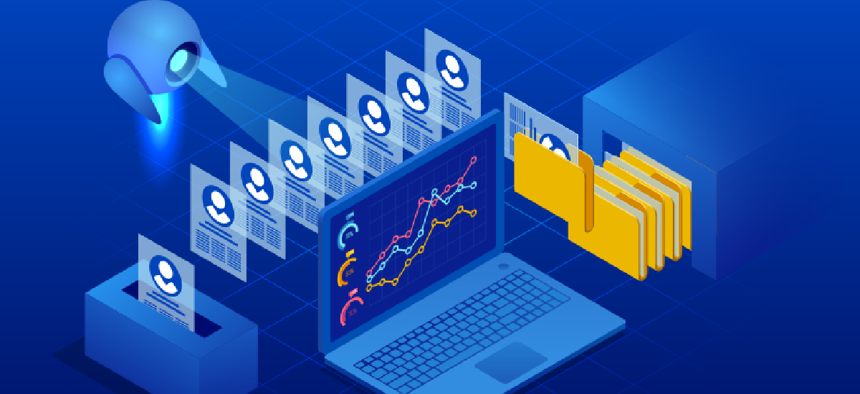How AI can speed the security clearance process

Continuous vetting, made possible by artificial intelligence and automation, provides a more deliberate and efficient process that protects data privacy, improves security and saves time and resources.
One of the largest threats to the public safety and security of the United States is the backlog of national security clearances for review. Each of the approximately 500,000 outstanding clearances represents a government position that isn’t being filled, vital national security work that is not being completed or a large incentive for talented people to reconsider the field of public service. Delays create major problems beyond hiring, especially for contractors in the defense and aerospace industries, which can result in slower operations, missed deadlines and a rushed hiring process.
In the meantime, shortcuts are being taken to patch the gaps. Many federal workers are operating on interim clearances. The National Background Investigations Bureau, which will transition from the Office of Personnel Management to the Defense Department by Oct. 1 of this year, is shifting from full periodic reinvestigations of active clearance holders to short, initial checks. In theory, this should take less time. However, analysts might miss major red flags like financial misconduct or vulnerability that can occur over time but require a deeper investigative process to reveal.
Despite the decrease in clearance inventory, the volume of data to be reviewed remains overwhelming. However, in order for investigators to be more efficient, their technology must be appropriate. The upshot is that we don’t have a people problem in background screening systems -- we have a data problem.
Fortunately, artificial intelligence and automation offer solutions to a process that is in dire need of overhaul. Gary Reid, director for defense intelligence at the Office of the Director of National Intelligence, said in recent testimony to the House Armed Services Committee that automation and continuous vetting checks are critical to reducing the workload of periodic reinvestigations, and the recent executive order creating the Defense Counterintelligence and Security Agency (DCSA) will enable this success.
New technologies are imperative to help the DOD navigate the deluge of data and combat agile threats. Here is how AI and automation can benefit the security clearance process.
What AI and automation can do for continuous vetting
Periodic reinvestigations are supposed to occur every five years for top secret clearances, but this has lagged due to budget constraints and the deluge of data needing review. A January 2017 Memorandum by the Office of the Undersecretary of Defense noted that due to the large number of backlog clearance cases, Tier 3 periodic reinvestigations would be delayed until the backlog was eliminated or a modernized solution is available. It also extended Tier 5 periodic reinvestigations from five to six years. Additionally, a 2014 review of the security clearance process found that resource constraints led government agencies to conduct fewer reinvestigations than required, and recommended continuous evaluation to increase the discovery of derogatory information that develops after initial adjudication.
For example, a DOD pilot program testing a continuous evaluation system using 3,370 government employees revealed that 21.7% of the test group did not report derogatory information that had developed since the last time the respective employee had been evaluated. Also, 3% of the employees had information serious enough to result in suspension or revocation of their clearance -- that is almost 100 employees who otherwise would have remained employed in high-security government positions.
Without continuous vetting processes, analysts spend time manually reviewing data on people who have minimal associated risk. This wastes valuable time and resources, in part because almost all people in positions of trust are, in fact, trustworthy. Additionally, waiting five to six years for a reinvestigation means wading tediously through five years of accumulated data, a process that can take several months.
Organizing analytical workloads by the presence or absence of threat-related information is intuitive and efficient. AI and automation can transform the continuous vetting process by leveraging training models to identify changes and patterns across five years’ worth of data and identify information that is worthy of human attention. This means the attention and skills of DCSA investigators can be fully engaged in the judgment and adjudication processes.
These exquisite measures of risk allow for less intrusion on citizen privacy. When using broad-brush, non-AI techniques, analysts face a large number of false positives. AI pinpoints exceptions to the established patterns, so humans don’t need to review data that doesn’t warrant evaluation. Because AI reviews changes in data, humans look at personal information only when a change in pattern is identified.
The upshot
The backlog of national security clearances for review presents one of the largest threats to public safety and national security. For many years, government agencies have declared that until a modernized solution was available, security clearance processes would remain delayed. Continuous vetting, made possible by AI and automation, provides a more deliberate and efficient process that protects data privacy, improves security and saves time and resources. The government doesn’t need to throw more people at an inefficient system -- it needs to upgrade the system to the most agile instrument available.





